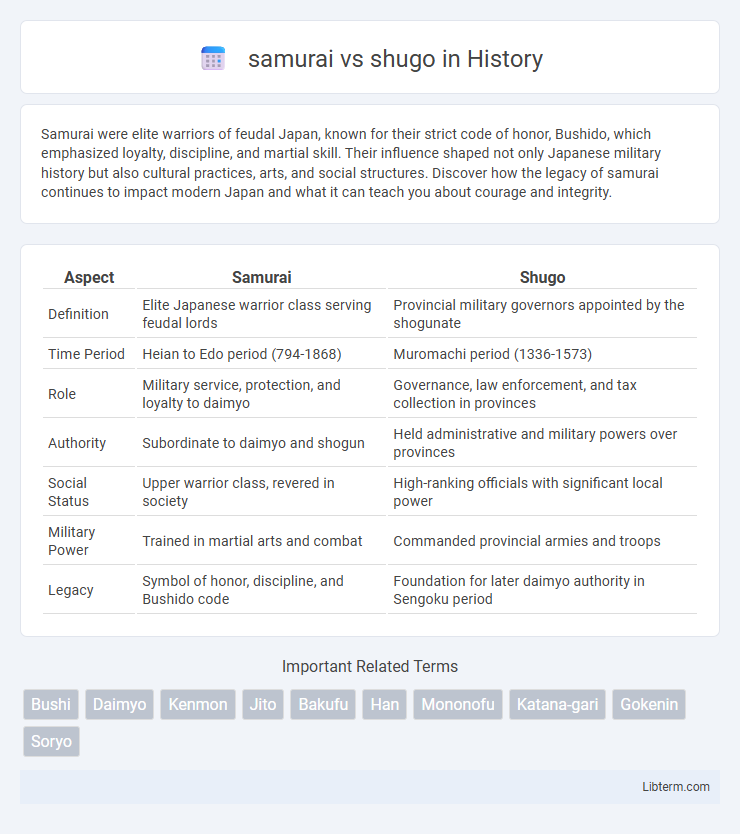Samurai were elite warriors of feudal Japan, known for their strict code of honor, Bushido, which emphasized loyalty, discipline, and martial skill. Their influence shaped not only Japanese military history but also cultural practices, arts, and social structures. Discover how the legacy of samurai continues to impact modern Japan and what it can teach you about courage and integrity.
Table of Comparison
| Aspect | Samurai | Shugo |
|---|---|---|
| Definition | Elite Japanese warrior class serving feudal lords | Provincial military governors appointed by the shogunate |
| Time Period | Heian to Edo period (794-1868) | Muromachi period (1336-1573) |
| Role | Military service, protection, and loyalty to daimyo | Governance, law enforcement, and tax collection in provinces |
| Authority | Subordinate to daimyo and shogun | Held administrative and military powers over provinces |
| Social Status | Upper warrior class, revered in society | High-ranking officials with significant local power |
| Military Power | Trained in martial arts and combat | Commanded provincial armies and troops |
| Legacy | Symbol of honor, discipline, and Bushido code | Foundation for later daimyo authority in Sengoku period |
Origins of the Samurai and Shugo
The origins of the samurai trace back to the Heian period in Japan, where they emerged as skilled warriors serving aristocratic landowners to protect estates and enforce local order. Shugo, established during the Kamakura period, were military governors appointed by the shogunate to oversee provinces, maintain peace, and collect taxes, marking a shift in feudal administration. Both samurai and shugo played pivotal roles in Japan's transition from court aristocracy to a decentralized military government.
Defining the Samurai: Roles and Responsibilities
Samurai were elite warriors in feudal Japan, serving as military retainers to the shugo, or military governors, who oversaw provinces during the Muromachi period. Their roles encompassed not only combat but also governance, law enforcement, and administration under the shugo's authority. This hierarchical relationship positioned samurai as both protectors of the domain and key agents in maintaining the shugo's regional power.
The Rise of the Shugo: Provincial Governance
The rise of the Shugo marked a transformative period in Japanese provincial governance during the Kamakura and Muromachi periods, as these military commissioners were appointed by the shogunate to oversee law enforcement, tax collection, and military conscription in provinces. Shugo gradually consolidated power, supplanting traditional aristocratic landholders and establishing localized control through fortified castles and samurai retainers. This shift enabled the samurai class to assert political authority beyond the battlefield, embedding military governance within the feudal administrative framework.
Social Status: Samurai vs Shugo
Samurai held military prestige as skilled warriors loyal to their daimyo, whereas shugo served as regional military governors appointed by the shogunate with administrative powers. Samurai typically belonged to a warrior class with direct combat roles, while shugo managed land, collected taxes, and maintained law and order in their provinces. The social status of samurai was defined by their martial service, contrasting with shugo's broader political authority and bureaucratic responsibilities within feudal hierarchy.
Military Functions and Authority
Samurai served as the military backbone of feudal Japan, executing combat duties, enforcing shogunal commands, and managing localized warfare with specialized combat skills and strict adherence to bushido. Shugo, as provincial military governors appointed by the shogunate, held authoritative powers to oversee samurai armies, maintain regional peace, collect taxes, and enforce laws within their jurisdictions. The hierarchical relationship positioned shugo as political and military administrators with broad governance over territories, while samurai operated as disciplined warriors executing strategic military functions under their command.
Power Dynamics in Feudal Japan
Samurai were the military nobility of Feudal Japan, wielding significant martial power and serving as loyal retainers to their lords. Shugo, appointed by the shogunate, acted as provincial governors who exercised administrative control and collected taxes, balancing military influence with political authority. The power dynamics between samurai and shugo often involved complex negotiations, as shugo depended on samurai's martial expertise to maintain order, while samurai relied on shugo's official status for legitimacy and resources.
Samurai Loyalty vs Shugo Control
Samurai exhibited unwavering loyalty to their daimyo, often demonstrating personal honor and commitment that transcended mere duty. In contrast, shugos exercised direct administrative and military control over provinces, relying on authority and governance rather than personal allegiance. This divergence shaped feudal Japan's power dynamics, where samurai loyalty reinforced social bonds while shugo control maintained regional order.
Key Historical Conflicts and Alliances
Samurai served as loyal warriors to shugo, the provincial military governors appointed by the Kamakura and Muromachi shogunates to maintain order and collect taxes, yet frequent power struggles arose as samurai clans sought to expand autonomy. Key conflicts like the Nanboku-cho Wars (1336-1392) pitted shugo-appointed armies against rebellious samurai factions vying for regional dominance. Alliances were fluid, with some shugo allying with influential samurai families to suppress uprisings, while others were overthrown by their own retainers, highlighting the complex feudal power dynamics in medieval Japan.
The Decline of Shugo Influence
The decline of Shugo influence in medieval Japan was marked by the rise of powerful samurai clans who increasingly asserted military and administrative control over provinces. Shugo officials, originally appointed by the shogunate to maintain order, gradually lost authority as samurai warlords established localized power bases during the Sengoku period. This shift reshaped the political landscape, diminishing centralized governance and paving the way for the emergence of daimyo-led domains.
Lasting Legacy: Samurai and Shugo in Japanese Culture
Samurai, the warrior class, and shugo, military governors during the Muromachi period, both played pivotal roles in shaping feudal Japan's political and social structures. Samurai culture emphasized honor, loyalty, and martial skill, influencing literature, arts, and modern Japanese values, while shugo established early administrative systems that evolved into the samurai-dominated shogunate governance. The lasting legacy of both is evident in Japan's historical identity, continuing to inspire cultural traditions and popular media worldwide.
samurai Infographic

 libterm.com
libterm.com